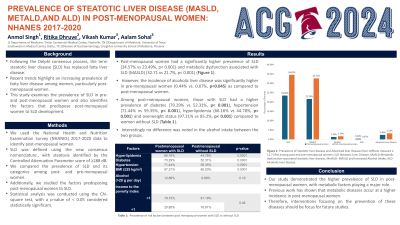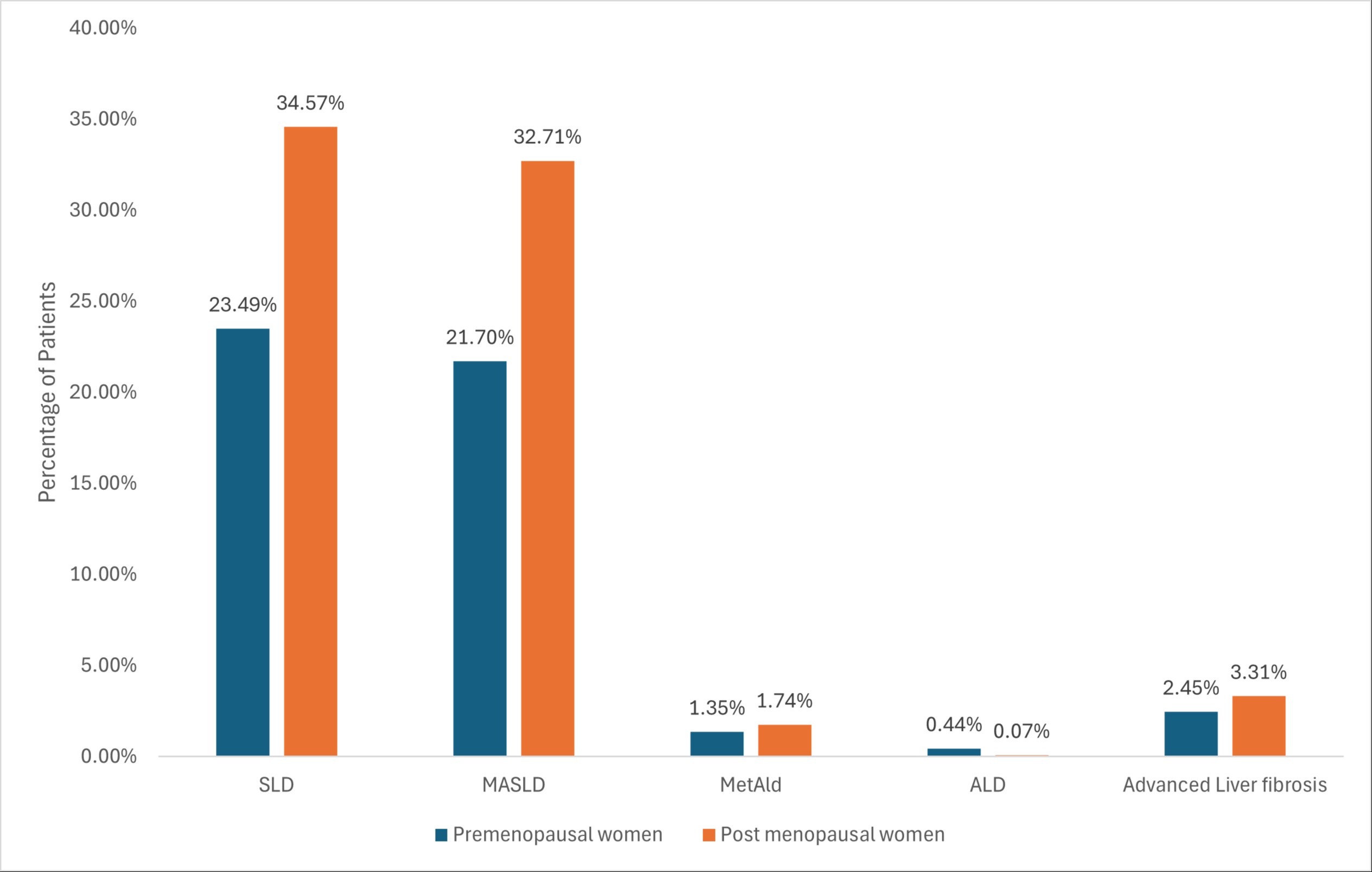Sunday Poster Session
Category: Liver
P1205 - Prevalence of Steatotic Liver Disease (MASLD, MetALD, and ALD) in Post-Menopausal Women: NHANES 2017-2020
Sunday, October 27, 2024
3:30 PM - 7:00 PM ET
Location: Exhibit Hall E

Has Audio
- AS
Anmol Singh, MBBS
Tristar Centennial Medical Center
Nashville, TN
Presenting Author(s)
Award: Presidential Poster Award
Anmol Singh, MBBS1, Ritika Dhruve, MBBS2, Vikash Kumar, MD3, Aalam Sohal, MD4
1Tristar Centennial Medical Center, Nashville, TN; 2University of Texas Southwestern Medical Center, Dallas, TX; 3Creighton University School of Medicine, Brooklyn, NY; 4Creighton University School of Medicine, Seattle, WA
Introduction: Following the Delphi consensus process, the term steatotic liver disease (SLD) has replaced fatty liver disease. Recent trends highlight an increasing prevalence of fatty liver disease among women, particularly post-menopausal women. This study examines the prevalence of SLD in pre-and post-menopausal women and also identifies the factors that predispose post-menopausal women to SLD development.
Methods: We used the National Health and Nutrition Examination Survey (NHANES) 2017-2020 data to identify post and pre-menopausal women. SLD was defined using the new consensus nomenclature., with steatosis identified by the Controlled Attenuation Parameter score of ≥288 dB. We compared the prevalence of SLD and its categories among post- and pre-menopausal women. Additionally, we studied the factors predisposing post-menopausal women to SLD. Statistical analysis was conducted using the Chi-square test, with a p-value of < 0.05 considered statistically significant.
Results: Post-menopausal women had a significantly higher prevalence of SLD (34.57% vs 23.49%, p< 0.001) and Metabolic dysfunction associated with SLD (MASLD) (32.71 vs 21.7%, p< 0.001) (Figure 1). However, the incidence of alcoholic liver disease was significantly higher in pre-menopausal women (0.44% vs. 0.07%, p< 0.045) as compared to post-menopausal women. Among post-menopausal women, those with SLD had a higher prevalence of diabetes (70.29% vs 52.31%, p< 0.001), hypertension (71.44% vs 59.35%, p< 0.001), hyperlipidemia (66.16% vs 44.78%, p< 0.001) and overweight status (97.21% vs 85.2%, 0.001) compared to women without SLD. Interestingly no difference was noted in the alcohol intake between the two groups.
Discussion: Our study demonstrated the higher prevalence of SLD in post-menopausal women, with metabolic factors playing a major role. Previous work has shown that metabolic diseases occur at a higher incidence in post-menopausal women. Therefore, interventions focusing on the prevention of these diseases should be a focus for future studies.

Note: The table for this abstract can be viewed in the ePoster Gallery section of the ACG 2024 ePoster Site or in The American Journal of Gastroenterology's abstract supplement issue, both of which will be available starting October 27, 2024.
Disclosures:
Anmol Singh, MBBS1, Ritika Dhruve, MBBS2, Vikash Kumar, MD3, Aalam Sohal, MD4. P1205 - Prevalence of Steatotic Liver Disease (MASLD, MetALD, and ALD) in Post-Menopausal Women: NHANES 2017-2020, ACG 2024 Annual Scientific Meeting Abstracts. Philadelphia, PA: American College of Gastroenterology.
Anmol Singh, MBBS1, Ritika Dhruve, MBBS2, Vikash Kumar, MD3, Aalam Sohal, MD4
1Tristar Centennial Medical Center, Nashville, TN; 2University of Texas Southwestern Medical Center, Dallas, TX; 3Creighton University School of Medicine, Brooklyn, NY; 4Creighton University School of Medicine, Seattle, WA
Introduction: Following the Delphi consensus process, the term steatotic liver disease (SLD) has replaced fatty liver disease. Recent trends highlight an increasing prevalence of fatty liver disease among women, particularly post-menopausal women. This study examines the prevalence of SLD in pre-and post-menopausal women and also identifies the factors that predispose post-menopausal women to SLD development.
Methods: We used the National Health and Nutrition Examination Survey (NHANES) 2017-2020 data to identify post and pre-menopausal women. SLD was defined using the new consensus nomenclature., with steatosis identified by the Controlled Attenuation Parameter score of ≥288 dB. We compared the prevalence of SLD and its categories among post- and pre-menopausal women. Additionally, we studied the factors predisposing post-menopausal women to SLD. Statistical analysis was conducted using the Chi-square test, with a p-value of < 0.05 considered statistically significant.
Results: Post-menopausal women had a significantly higher prevalence of SLD (34.57% vs 23.49%, p< 0.001) and Metabolic dysfunction associated with SLD (MASLD) (32.71 vs 21.7%, p< 0.001) (Figure 1). However, the incidence of alcoholic liver disease was significantly higher in pre-menopausal women (0.44% vs. 0.07%, p< 0.045) as compared to post-menopausal women. Among post-menopausal women, those with SLD had a higher prevalence of diabetes (70.29% vs 52.31%, p< 0.001), hypertension (71.44% vs 59.35%, p< 0.001), hyperlipidemia (66.16% vs 44.78%, p< 0.001) and overweight status (97.21% vs 85.2%, 0.001) compared to women without SLD. Interestingly no difference was noted in the alcohol intake between the two groups.
Discussion: Our study demonstrated the higher prevalence of SLD in post-menopausal women, with metabolic factors playing a major role. Previous work has shown that metabolic diseases occur at a higher incidence in post-menopausal women. Therefore, interventions focusing on the prevention of these diseases should be a focus for future studies.

Figure: Figure 1: Prevalence of Steatotic liver disease and Advanced liver disease (liver stiffness measure ≥ 11.7 kPa) among post and pre-menopausal women; SLD-Steatotic Liver Disease, MASLD-Metabolic dysfunction-associated steatotic liver disease, MetALD- MASLD and Increased Alcohol Intake, ALD-Alcoholic liver disease.
Note: The table for this abstract can be viewed in the ePoster Gallery section of the ACG 2024 ePoster Site or in The American Journal of Gastroenterology's abstract supplement issue, both of which will be available starting October 27, 2024.
Disclosures:
Anmol Singh indicated no relevant financial relationships.
Ritika Dhruve indicated no relevant financial relationships.
Vikash Kumar indicated no relevant financial relationships.
Aalam Sohal indicated no relevant financial relationships.
Anmol Singh, MBBS1, Ritika Dhruve, MBBS2, Vikash Kumar, MD3, Aalam Sohal, MD4. P1205 - Prevalence of Steatotic Liver Disease (MASLD, MetALD, and ALD) in Post-Menopausal Women: NHANES 2017-2020, ACG 2024 Annual Scientific Meeting Abstracts. Philadelphia, PA: American College of Gastroenterology.

